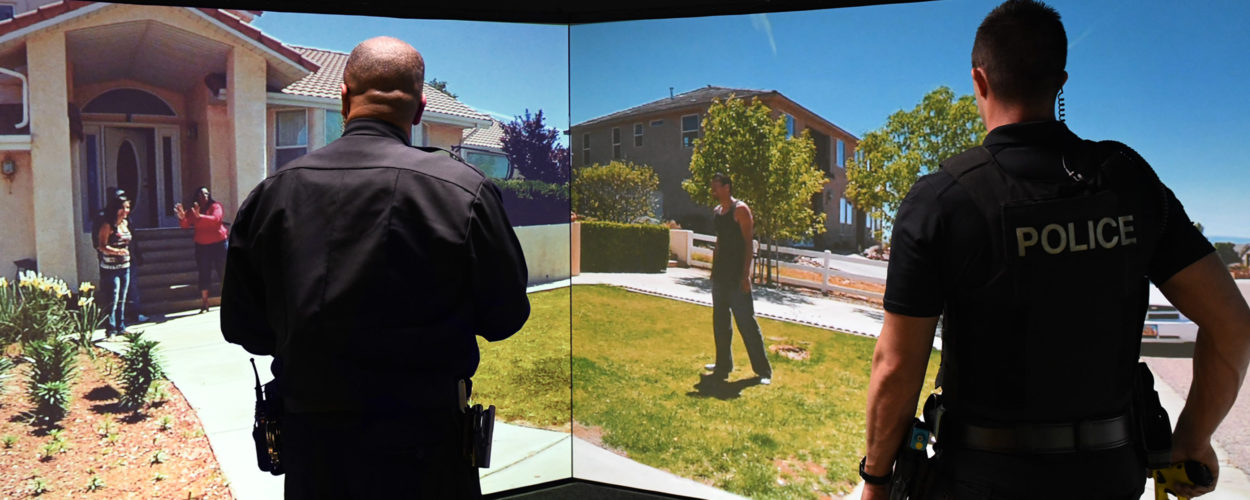
Physical and Psychological Fidelity in Law Enforcement Training
Training is a combination of skill acquisition and skill transfer, with skill transfer being the most challenging—especially in police simulators. This is because skill transfer requires an environment that provides a blend of physical and psychological fidelity, which some simulated environments struggle with.
Realism in VirTra’s Use of Force Simulators
VirTra, however, overcame this issue with high-fidelity products. In VirTra’s simulators, the physical realism is found within the virtual training simulator itself, as realistic scenarios encourage skill development and transfer to the field. “Realistic” is the key word: VirTra uses high-definition video of real people, locations and animals for the most immersive, real-life experience.
As for psychological fidelity, each training simulator and police scenario is designed to create essential underlying psychological processes relevant to key performances in the real-world setting. In other words, the simulator makes trainees feel confused, stressed or overwhelmed just as they would in the field. Trainees learn how to handle the psychological pressures and have a clear head in stressful situations—a crucial skill for life in the field.
But none of this would be possible without the realistic visuals. Using CGI instead of actors effects both sides of the skill transfer equation:
-If the person on-screen looks like a video game character, the environment is not physically realistic.
-If there is no physical realism, the psychological realism decreases, as trainees struggle to feel stress and other real-life pressures with a cartoon-esque subject.
All in all, what department would want their trainees learning crucial skills such as de-escalation and use of force with video game characters instead of real people?
How CGI Can Hurt Law Enforcement Training
CGI-based police simulations that are intended to help trainees may actually do more harm than good by creating training scars. For example, consider judgmental use of force scenarios. CGI humans can mimic basic human behaviors and movements. But they lack the ability to show subtle body language, micro-expressions and other cues for trainees to analyze and react to.
This point builds off the physical fidelity, or with CGI, the lack thereof. High-definition video of professional actors in police training simulations are needed for high-fidelity training.
Virtual Training Simulators Vs. Roleplaying
CGI and simulation-based training are only a few different training solutions. Another is roleplaying, which is incredibly realistic and checks the box for both physical and psychological fidelity. However, it is expensive in time and products, requiring props, locations, actors and special effects. Though a wide variety of scenarios can be realistically recreated, the cost limits the amount of training officers may receive.
This is where police simulation training bridges the gap between high-fidelity training and cost. Police simulation training is equipped with a wide variety of scenarios, characters and branching options. This allows realistic, repeatable, in-depth and cost-saving training experiences with no clean-up or traveling required. For increased realism, trainees can use their personal firearms in the simulator with the drop-in laser recoil kit and CO2 magazine. This minimizes harm, saves money in ammunition and provides well-rounded training.
Why Police Simulators Improve Department Training
Police training simulators are often the best solution for most agencies and departments. Utilizing real actors instead of CGI allows trainees to learn to look for the subtle nonverbal communication—slight hesitation, tensing, micro-expressions—that people naturally produce and CGI is not yet advanced enough to recreate. While role-playing also uses real people for a high-fidelity practice, the cost and time required make it a difficult, constant training solution.
With VirTra, training with real people on-screen makes it so there is no difference between training sessions and what trainees will see on the street. This allows for successful skill transfer while minimizing potential training scars. For more information about scenario-based training, contact a VirTra specialist.







